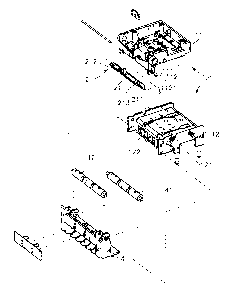Some of the information on this Web page has been provided by external sources. The Government of Canada is not responsible for the accuracy, reliability or currency of the information supplied by external sources. Users wishing to rely upon this information should consult directly with the source of the information. Content provided by external sources is not subject to official languages, privacy and accessibility requirements.
Any discrepancies in the text and image of the Claims and Abstract are due to differing posting times. Text of the Claims and Abstract are posted:
| (12) Patent Application: | (11) CA 2460555 |
|---|---|
| (54) English Title: | AUTO-BILL-DISPENSING MACHINE |
| (54) French Title: | DISTRIBUTRICE A BILLETS AUTOMATIQUE |
| Status: | Deemed Abandoned and Beyond the Period of Reinstatement - Pending Response to Notice of Disregarded Communication |
| (51) International Patent Classification (IPC): |
|
|---|---|
| (72) Inventors : |
|
| (73) Owners : |
|
| (71) Applicants : |
|
| (74) Agent: | SMART & BIGGAR LP |
| (74) Associate agent: | |
| (45) Issued: | |
| (22) Filed Date: | 2004-03-10 |
| (41) Open to Public Inspection: | 2004-09-28 |
| Availability of licence: | N/A |
| Dedicated to the Public: | N/A |
| (25) Language of filing: | English |
| Patent Cooperation Treaty (PCT): | No |
|---|
| (30) Application Priority Data: | ||||||
|---|---|---|---|---|---|---|
|
An auto-bill-dispensing machine is provided. The auto-bill-dispensing machine
comprises bill receiver having a plurality of security hooks positioned
axially between
two positioning plates formed on the two sides of the upper chassis of the
bill receiver,
and the security hooks are against within a plurality of blocking grooves of
the lower
chassis to block the bill passage. When the bill enters into the bill passage
and being held
against on the security hooks, the security hooks of the bill receiver will be
out of the
blocking groove of the lower chassis to let the bill pass through, and after
the bill passes
the security hooks, the security device will return to the original position
to make the
security hooks support within the blocking groove of the lower chassis to
prevent the bill
being pulled back by a string, a tape, a steel wire or a glued metallic plate.
Note: Claims are shown in the official language in which they were submitted.
Note: Descriptions are shown in the official language in which they were submitted.

2024-08-01:As part of the Next Generation Patents (NGP) transition, the Canadian Patents Database (CPD) now contains a more detailed Event History, which replicates the Event Log of our new back-office solution.
Please note that "Inactive:" events refers to events no longer in use in our new back-office solution.
For a clearer understanding of the status of the application/patent presented on this page, the site Disclaimer , as well as the definitions for Patent , Event History , Maintenance Fee and Payment History should be consulted.
| Description | Date |
|---|---|
| Inactive: IPC expired | 2019-01-01 |
| Application Not Reinstated by Deadline | 2010-03-10 |
| Time Limit for Reversal Expired | 2010-03-10 |
| Deemed Abandoned - Failure to Respond to Maintenance Fee Notice | 2009-03-10 |
| Inactive: IPC from MCD | 2006-03-12 |
| Inactive: IPC from MCD | 2006-03-12 |
| Inactive: IPC from MCD | 2006-03-12 |
| Inactive: IPC from MCD | 2006-03-12 |
| Application Published (Open to Public Inspection) | 2004-09-28 |
| Inactive: Cover page published | 2004-09-27 |
| Inactive: <RFE date> RFE removed | 2004-08-18 |
| Inactive: Adhoc Request Documented | 2004-08-17 |
| Amendment Received - Voluntary Amendment | 2004-07-23 |
| Request for Examination Received | 2004-07-23 |
| Inactive: First IPC assigned | 2004-05-18 |
| Inactive: IPC assigned | 2004-05-18 |
| Inactive: Filing certificate - No RFE (English) | 2004-04-15 |
| Letter Sent | 2004-04-15 |
| Application Received - Regular National | 2004-04-15 |
| Abandonment Date | Reason | Reinstatement Date |
|---|---|---|
| 2009-03-10 |
The last payment was received on 2008-02-26
Note : If the full payment has not been received on or before the date indicated, a further fee may be required which may be one of the following
Patent fees are adjusted on the 1st of January every year. The amounts above are the current amounts if received by December 31 of the current year.
Please refer to the CIPO
Patent Fees
web page to see all current fee amounts.
| Fee Type | Anniversary Year | Due Date | Paid Date |
|---|---|---|---|
| Application fee - standard | 2004-03-10 | ||
| Registration of a document | 2004-03-10 | ||
| MF (application, 2nd anniv.) - standard | 02 | 2006-03-10 | 2006-02-14 |
| MF (application, 3rd anniv.) - standard | 03 | 2007-03-12 | 2007-01-30 |
| MF (application, 4th anniv.) - standard | 04 | 2008-03-10 | 2008-02-26 |
Note: Records showing the ownership history in alphabetical order.
| Current Owners on Record |
|---|
| INTERNATIONAL CURRENCY TECHNOLOGIES CORPORATION |
| Past Owners on Record |
|---|
| YA-HUI YANG |
| YI-CHIA LIN |